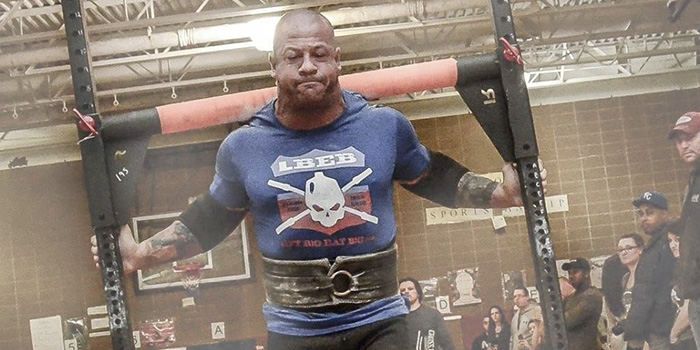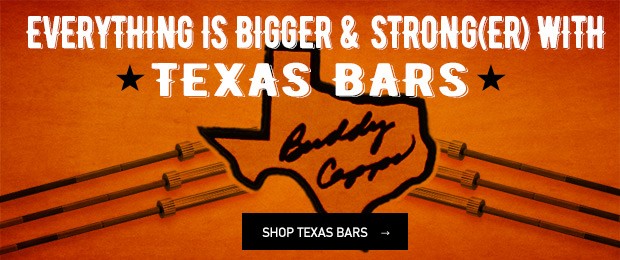
For most of my lifting career, my weak point in the deadlift was always off the floor, whether I pulled sumo or conventional. Of course, any good program will focus on bringing up the weak points of all of your main lifts. To keep progressing, I focused on deficit deadlifts and speed pulls to improve my pull off the ground. I was able to work up to an 800-pound sumo deadlift in competitions by focusing on these weak points without making much of a change in the program. I’m a big believer in the idea that if it’s not broke, don’t fix it. I see a lot of beginners to intermediates thinking they have to change their accessory work constantly. As long as you are making progress, I see no need to make changes. My sumo was always my best lift, but unfortunately, due to a groin injury, I’m not able to pull sumo for the time being. This was very discouraging at first, as sumo came naturally to me. Getting in position for the sumo simply felt more comfortable than doing it for the conventional, and I could use my legs much more. I wasn’t going to let this hold me back, so I switched to conventional moving forward. I thought this would work out well for me in the long run because I also compete in strongman, where the sumo is not allowed.
RECENT: Kettlebells for Strongman
As I got stronger with pulling conventional, a funny thing happened. My weak point went from being off the floor to just below the knee. During this time, my form greatly improved, and I was able to get much more leg drive to get the bar moving. I was also about 20 pounds heavier than when I was pulling sumo, which can change your mechanics. I had a conversation with Dave Tate at my last visit to the compound, and he told me how he used to pull sumo until his weight rose to 275. He had to make the switch to conventional. My weight is 275 at the moment, and I’m definitely feeling like conventional is now a better pull for me. With a new weak point, I needed a new approach to my training. I changed my accessory work to focus on my lockout with a couple of key exercises to improve the middle of the deadlift. I’ve seen many dropped deadlifts here, and I know from experience how frustrating it is. I used to always have the attitude when I approached the bar that as long as I got it moving, I could lock it out. This was completely new to me, so I had to go back to the drawing board and figure out what exercises would get me stronger.
1. Pause Deadlifts
The paused deadlift will dramatically increase your lockout strength. The setup of this deadlift mirrors that of a normal deadlift, but you will pause anywhere from mid-shin to right below your patella for 2-3 seconds. Your pause is going to be where you are weakest, but I generally have people pause right below the knees. With this exercise, you want to have impeccable form! You do not want to pause with a heavy weight in this position, with the knees locked and back rounded. If you have never tried these, then start with 55-60% of your one rep max. In the first few weeks, work on perfecting your technique and SLOWLY adding weight to the bar each week. Make sure that you are in the proper position at the pause, and do not let out your air, just like with pause squats. Have someone count, and once he or she says “two,” drive the hips and squeeze the glutes hard to lock the bar out as fast as possible. I also prefer to do these beltless, but that’s my personal preference.
2. Goodmornings
I feel that goodmornings can get a bad rap, but this is mainly due to people butchering the form. Don’t turn this into a half-leaning forward squat just to add more weight to the bar. Keep just a slight bend in the knees, with the back tight and an arched hard. Hinge at the hips, keeping the chest up until you feel a big stretch in the hamstrings. Done correctly, this is a great exercise for your whole posterior chain, and it’ll greatly improve your deadlift lockout. Personally, I love these on the Rackable Cambered Spider Bar, as it’s easier on the low back, with the weight being closer to your center of gravity.
3. Scrape the Rack Rows
A common weak point on the deadlift is the lats. The lats are extremely important on the setup, as they need to be engaged hard before the start of the pull. However, oftentimes the lifter does not stay tight through the pull, and the bar shifts away from them. Generally, when the lats don’t stay tight, the lifter’s back will round like a fishing pole, making the lockout near impossible, or resulting in some ugly hitch. The “scrape the rack” row teaches you to keep the bar pulled in tight to the racks, as you have to keep the bar pulled in tight during the deadlift.
4. Deadlift
Many times we see beginners ask how they can improve a certain lift. The answer is usually to simply perform the lift more, as it should be first in a program. Fancy accessory work isn’t always the answer. I always deadlifted, and it was rarely above 90%. All of my work was between 80% and 90% for multiple reps and sets, and I made sure that my form was perfect. One way to work through a weak point is not to give in to it. I see a lot of lifters hitch their way through their deadlifts, reinforcing bad form over and over again. Now if you are a strong(wo)man competitor, then by all means, hitch when it comes down to a competition, as it’s allowed. However, in training, you are just masking a weak point rather than working on it. If you are a powerlifter, then it never makes sense to pull with a hitch. You need multiple reps and sets to build strength while not trying to max out every week, letting your form go to trash. This is why 5th Set is a great program; you start with the main lift for repetitions, then choose a similar movement that works on your weak point.
So that you can see the progress I’ve made, about a year ago, I was very close to matching my best sumo deadlift, and as you can see, I gave out right at my weak point.
It took a lot of time and patience, but it took me a whole year to get back to this weight and to get it.
To show you an example of how my training went, here is how you would implement these lifts:
1. Deadlift: 640 (80%) 4 x 2, 5th set max reps
2. Pause Deadlifts: 520 (65%) 3 x 3
3. Goodmorning: 3 x 10
4. Inverse Leg Curl/Glute Ham Raise: 3 x 10
5a. Reverse Hypers: 3 x 15
5b. Ab Wheel: 3 x 15











2 Comments